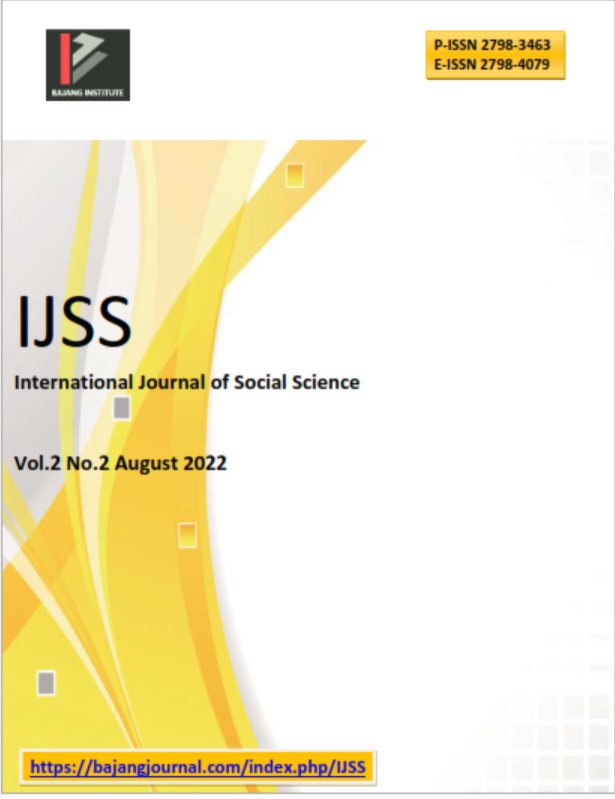PROTECTION OF CHILDREN VICTIMS OF VIOLENCE IN THE FAMILY PERSPECTIVE OF ISLAMIC FAMILY LAW AND POSITIVE LAW (Study at the Lampung Province Child Protection Institute, the Damar Lampung Child Advocacy Institute and the Regional Technical Implementation Uni
DOI:
https://doi.org/10.53625/ijss.v2i2.3079Keywords:
Child Protection Child and women advocacy institution of Damar LampungAbstract
A child protection refers to any efforts aimed at ensuring and protecting children and their rights so that they can grow, develop, and contribute to their full potential while remaining safe from violence and discrimination. Child protection is handled by a number of organizations, namely the Child Protection Institute, Lampung, the child advocacy institution of Damar Lampung, and the Technical Implementation Unit for the Protection of Women and Children, Lampung. Despite the fact that these three organizations exist and operate, family violence against children continues to rise. The conclusions are (1) Threats, compulsion, fear, opportunity, power relations, economy, patriarchy, lack of morals, inability to control themselves, retribution, and lack of attention from biological moms to children's behavior are all prevalent reasons of violence against children in three institutions. The difference is that there is a sexual disorder, husband is afraid of his old wife, lack of communication between children and mother, home environment, access to meet is cut off, mother dies, revenge, persuasion, habit of having sexual relations. Study/add insight into Islam and practice it, learn and practice good morals, hang out a lot with pious and pious people, exercise self-control, psychological approach, intensity of education are some of the solutions to decrease them. (2) The types of services provided by child protection institutions, child advocacy institutions, and the Technical Implementation Unit for the Protection of Women and Children (UPTD PPA) are similar in terms of type of service, legal basis, service principle, Standard Operating Procedure (SOP) for mentoring, code of ethics, and ethics, but each has its own characteristics in terms of technical assistance, human resources, funding sources, and facilities. (3) The hadhanah concept (care, care, and education) is reflected in the perspective of Islamic family law and positive law on child protection carried out by three institutions, referring to Law No. 4 of 1979 concerning Child Welfare, Law No. 35 of 2014 on Child Protection, Law No. 11 of 2012 on Child Criminal Justice, Law No. 23 of 2004 on Marriage, Compilation of Islamic Law leading to District Courts (Criminal), Religious Courts (Civil), and Mediation.
References
Abu Huraerah. Kekerasan Terhadap Anak. Bandung: Nuansa Cendikia, 2018
Abu Ishaq Al-Syatibi, al-Muwafaqat fi Ushul al-Syariah, jil. 1 Beirut: Dar al Ma’rifah,1996
Abdulrahman Al-Jaziri. Kitab Al-Fiqh ala al-Mazahib al-Arba’ah (Kairo: Dar al-Hadits, Tanpa Tahun), J. IV
Ahmad Al-Mursi Husain Jauhar. Maqashid Syariah.Jakarta: Amzah, 2013
Bagong Suyanto. Masalah Sosial Anak. Edisi Revisi. Surabaya: Kencana Persada Media Group:2015
Cyitarini Dian Samodra, Ira Paramatri. Dinamika Psikologis Korban Kekerasan Seksual Masa Anak. Jurnal Psikologi Klinis Indonesia , Volume 4 Nomor 2 2019
Dei Chafsoh, Nurhasan, dwi Ari Kurniaati. Dampak Ketidakharmonisan keluarga dalam perkembangan kehidupan anak menurut Hukum Islam dan perspektif Sosiologis (Studi Kasus di desa Plossosari Kecamatan Puri Kabupaten Mojokerto). Jurnal: Jurnal Ilmiah Hukum Keluarga Islam. Volume 1 Nomor 2 Tahun 2019
Departemen Agama Republik Indonesia. Al-Qur’an dan Terjemah. Bandung: CV. Diponegoro, 2018
Ibnu Qayyim al-Jauziyyah, Tuhfatul Maudûd bi Ahkâmil Maulûd, Hanya Untukmu Anakku. Jakarta: Pustaka Imam Asy-Syafi’I, 2016
Jalaluddin Al-Mahalli, Jalaluddin As-Suyuti. Tafsir Al-Jalalain Al-Muyassar. cet ke-1 (t.p: 2003)
Komisi perlindungan Anak Indonesia. Undang-undang Republik Indonesia Nomor 35 Tahun 2014 tentang perubahan Undang-undang Nomor 23 Tahun 2002 Tentang Perlindungan Anak dan Undang-undang Republik Indonesia nomor 17 Tahun 2016 Tentang Perpu Nomor 1 Tahun 2016 Tentang Perubahan Kedua Atas Undag-undang Nomor 23 Tahun 2002 Tentang Perlindungan Anak Menjadi Undang-undang. 2018
Khoirudin Nasution. “Perlindungan Terhadap Anak Dalam Hukum Keluarga Islam Indonesia.” Jurnal Al ‘Adalah Volume XIII No 1 Juni 2016
Lailan Rafiqah. Konsep Ibnu Qayyim Al-Jauziyah Tentang Perlindungan Hak Dalam Keluarga. Jurnal Al-Himalaya Volume 4 Nomor 1 Maret 2021Sugiyono. Metode Penelitian Kuanttaif, Kualitatif, dan R&D. Bandung: Al Fabeta, 2018
Lembaga Advokasi Anak Damar. SOP (Standar Oprasional Pelayanan) Layanan Pendampingan Kekerasan Berbasis Gender Dan Perdagangan Orang Pada Perempuan dan Anak. 2021
Mohammad Naziir. Metode Penelitian.Jakarta: Ghalia Indonesia, 2018
Mohammad Taufik Makarao, Weny Bukarno, Syaiful Azri. Hukum Perlindungan Anak dan Penghapusan Kekerasan dalam Rumah Tangga. Jakarta: Rineka Cipta, 2013
Nurjanah. Kekerasan Pada Anak Dalam perspektif Pendidikan Islam. Jurnal al-Afkar. Volume 1 No 2 Juli 2018
Ristianto, Edwin, Kekerasan Terhadap Anak dalam Keluarga (Tinjauan Hukum Islam Terhadap UU No.23 Tahun 2002), Yogyakarta: UIN Sunan Kalij jaga, 2010
St Rahmah. Peran Keluarga Dalam pendidikan Akhlak. Jurnal Albinar (Jurnal Ilmu dan teknik Dakwah) Volume 04 Nomor 07 Januari-Juni 2016
Tita Rostitawati, “Konsep Pendidikan Akhlak Anak Dalam Perspektif Al-ghazali”, Jurnal Tadbir: Jurnal Manajement Pendidikan Islam. Volume Nomor 1 Februari 2016.
Wahbah Zuhaili, Al-Fiqh Al-Islamy wa Adillatuhu. cetakan ke-2 Jilid 7, (Dmaskus: Daar Al-Fikr, 1405H),
Downloads
Published
How to Cite
Issue
Section
License
Copyright (c) 2022 Sulastri, Sovi Septania

This work is licensed under a Creative Commons Attribution 4.0 International License.

















